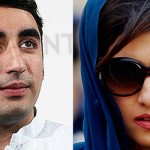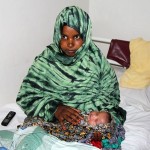I have noticed a trend on Facebook of pages created and maintained by male religious teachers in the Malay-speaking communities of Singapore, Malaysia and Indonesia. CahayaIslam (“Light of Islam”) and Lukisan Dakwah Islam (“Islamic Drawings for Da’wah”) are two pages most intriguing to me for two reasons: because they create and share cartoons that are drawn in the style of manga, which is popularly associated with comic books cheaply available to children and youth; and because they circumvent the rule in many forms of orthodox Islam against representations of the human form in art.
It seems that this abovementioned rule can be suspended if the images have noble purposes, such as spreading messages about Islam or being a good Muslim. The popularity of these pages suggests that this interpretation is acceptable. These pages have a large following; the “likes” total in the tens of thousands. Many of the cartoons posted on the site receive many positive comments and are shared thousands of times. Thus, it seems to be a fair representation of the dominant ideas about what is considered “Islamic” by a large portion of the Malay-speaking community.
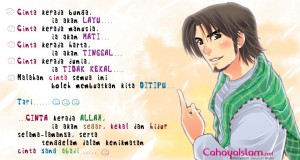
The main differences I noticed were in the implicit messages for the young Muslim woman and the young Muslim man. Looking over the various CahayaIslam cartoons depicting a young man, I could conclude that a young Muslim man should love God and love the Prophet Muhammad, pray, repent, seek spiritual success, and help those around him. In other words, he should embody the main tenets of Islam and many of the virtues that the Quran teaches us to strive towards. Lukisan Dakwah Islam also focuses on prayer (even linking it to being a macho man!), brotherly love and knowledge of Allah as our Creator. Noble da’wah work, right?
However, young women get a different message. As a little girl, being good means to pray-fast-and-obey-God-and-her-parents-and-later-her-husband. When she is older, she is shy and modest, because it is part of a woman’s attractiveness. She never forgets to follow the four rules of covering her aurat: don’t show your skin colour, don’t show the shape of your body, don’t attract attention, don’t use perfume (I guess there wasn’t enough space to include intellect and personality).
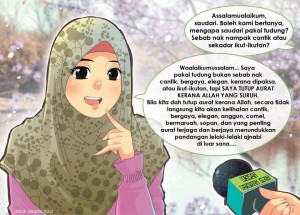
A good Muslim woman should love God and do good deeds! But piety is only to be a source of happiness to someone else (insert any male authority figure here), and her status is at par with other pleasant things such as a large house, good neighbours, and a comfortable vehicle (which of these material possessions do not belong?). Being a pious wife should be her lifelong ambition. Clearly, the scope of a woman’s ambition is woeful compared to what men can be. Likewise, cartoons from Lukisan Dakwah Islam focus on her dress code (here, here, here, the list goes on!) and acts of worship as a wife (horrifyingly also reminding women that they’ll easily end up in Hell.)
Another well-shared photo from this page includes tips on how to raise boy and girl children, differentiating between their potentials. Besides the expected gendered differences on how boys should learn “masculine” skills like fixing engines and electrical items while girls should learn “feminine” skills such as housework, I was appalled to read that boys should do volunteer work and obtain passports to travel for their studies or just “for the experience,” while girls should know only what is related to reproduction and every sort of bleeding that they could possibly have in their lifetime.
Wherever these ideas are coming from, they are definitely being absorbed into the consciousness of today’s Muslims.
I found these cartoons worth highlighting because, as mentioned before on MMW, cartoons make it easier to transmit certain messages. CahayaIslam and Lukisan Dakwah Islam have a following of mostly young adults, this is reflected by their method of da’wah (Facebook) and content (visual, colourful, manga-style). I find most of the gendered messages to be highly unrealistic, because of the historically more egalitarian gender relations in this geographical region even after the coming of Islam. Before the regional Islamic revival of the 1980s, Muslims did not make a big deal about women working, travelling, or covering their hair. Perhaps these cartoons are indicating a growing trend towards a more conservative brand of Islam.
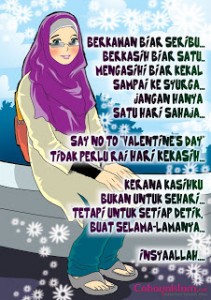

Nevertheless, there was one cartoon that definitely reflected reality – if not in its message, then in the reactions to it, which even prompted the creation of a new version. Just like in real life, even the bodies of cartoon Muslimahs are policed if she does not cover her aurat properly. The following photo was uploaded in the CahayaIslam group as part of a colouring contest about discouraging Valentine’s Day, but other Facebook users soon pointed out the irrelevant fact that her (cartoon) feet were also a private part (according to the Shafi’i school of thought, which is predominant in the region) and should have been covered with socks!
Even though these cartoons are a new way of reaching out to Muslim youth, the messages they send are definitely not revolutionary, but instead, conventional and highly gendered. As Malay society evolves and absorbs norms and customs from other cultures (especially from the Middle East, as these are deemed superior), the common denominator seems to be conservatism and a rigid differentiation between women and men.
I find this worrying because of how easily these messages could be absorbed by today’s young Muslim women and men. They are living in secular, developing countries where women study, work, and appear in public alongside men and will probably to continue to do so for economic reasons. But in the name of religion, young women are receiving messages that limit their potentials, while young men are receiving messages that reinforce their privileges.
What is the future of Malay Muslim society going to look like?

